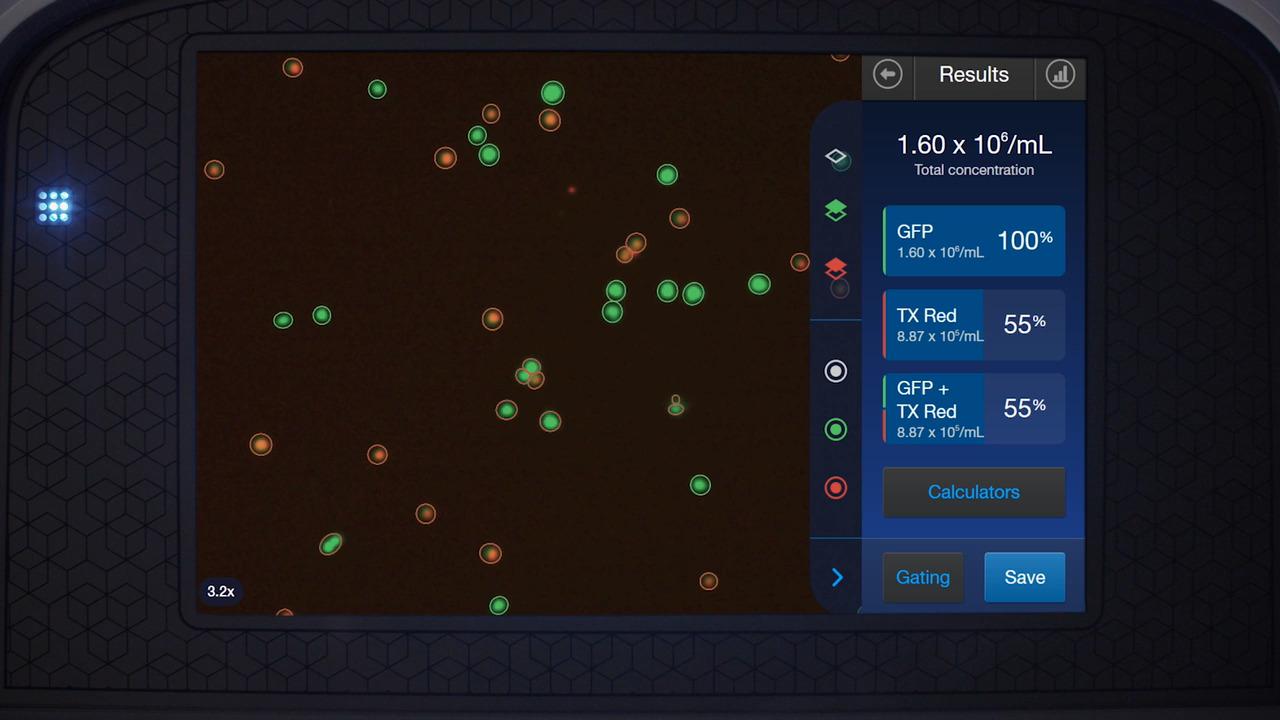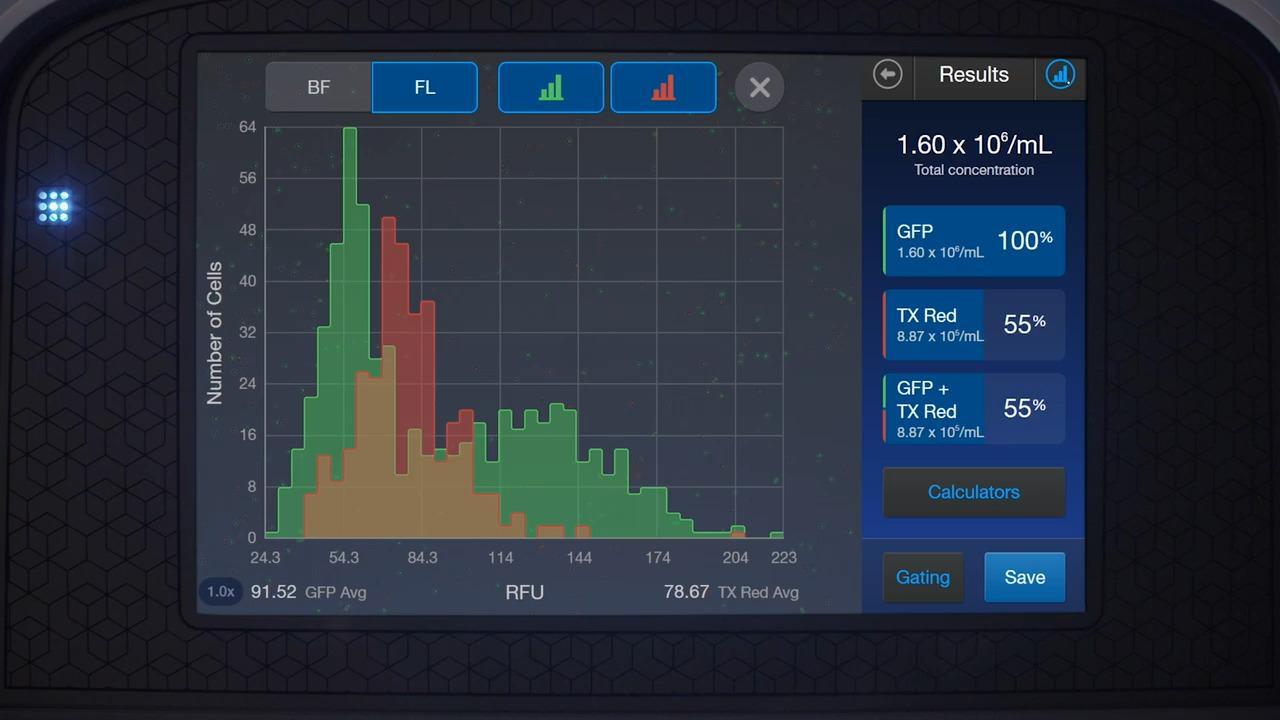
Dual fluorescence and brightfield cell counting
The Invitrogen Countess 3 FL Automated Cell Counter has fluorescence capabilities with two easily interchangeable fluorescent light cubes selected from 14 spectrum-spanning options. The Countess 3 FL instrument can count cells and measure viability in fluorescent mode as well as brightfield, while also reporting fluorescent protein expression, apoptosis, transfection efficiency, and cell viability using fluorescent reagents in as few as 30 seconds. With the utilization of artificial intelligence during development, our team has applied deep-learning neural network algorithms to generate highly accurate cell counts, even for the most challenging cell sample types.
Fluorescence cell counting also allows the use of fluorescence-based cellular assays that offer more specificity with complex samples by using fluorescent cellular stains or fluorescently tagged cells.
Countess 3 FL Automatic Cell Counter features
The Countess 3 FL instrument shares common features with the Countess 3 model: It is accurate, precise, fast, simple, and automated; it offers viability measurement and single-cell data across a wide variety of cell lines; it is compatible with reusable slides; and it has optional software to support 21 CFR Part 11 compliance for electronic records. In addition, its fluorescence capabilities open up additional options and applications.
Fluorescence applications
Advanced viability, apoptosis, transfection efficiency, fluorescent protein expression, and more.
Interchangeable LED light cubes
Extend your choice of fluorescent proteins and dyes beyond GFP and RFP
Optimized Ready Count reagents
Designed for the Countess 3 FL cell counter
Fluorescence counting applications
In addition to counting cells, the fluorescence capabilities of the Countess 3 FL instrument are often used to assess cell viability, apoptosis, transfection efficiency, and fluorescent protein expression. But the applications extend to any cellular parameters that are autofluorescent or can be labeled using fluorescent dyes. You’ll find data illustrating cell culture quality control, CAR-T cell screening, CRISPR-Cas9 editing efficiency, and other fluorescence applications in Sample Data.
Cell viability. Assessing cell viability is a key step in daily cell culture and is required for accurate and efficient downstream processing. The Countess 3 FL fluorescence options offer a sensitive and specific viability check that can be performed quickly and easily prior to downstream sample analysis.
Although trypan blue is widely used for viability assessment in brightfield cell counting, it can alter cell morphology in certain cases. For example, when dead mouse PBMCs are stained with trypan blue, they can expand and sink to a different focal plane than live cells, complicating accurate detection and counting. As a fluorescence alternative, Invitrogen ReadyCount Green/Red Viability Stain contains acridine orange and propidium iodide (AO/PI) in an optimized combination. Fluorescent staining provides great sensitivity and greater specificity of live/dead status in a mixed cell population without altering the morphology of the cell.
Apoptosis detection. Fluorescent stains can target different aspects and stages of apoptosis, such as plasma membrane alterations (Annexin V), mitochondrial changes (JC-1), or caspase activation (Caspase 3/7). Pairing one of these with a viability stain on the Countess 3 FL can identify apoptotic as well as live and dead cells.
Transfection efficiency. Assessing the percentage of cells successfully transfected or transduced in a population is critical for research. Commonly, transfection or transduction is paired with a fluorescent protein reporter such as GFP. The Countess 3 FL Automated Cell Counter, loaded with your choice of light cubes, offers a quick and simple method to easily obtain transfection efficiency data.
Transfection efficiency
Jurkat cells were transfected with a GFP expression vector. (left) Cells can be seen adhered to the vessel in this image captured on an EVOS M5000 Imaging System. (right) Cells were trypsinized and counted on a Countess 3 FL Cell Counter equipped with an EVOS GFP light cube. Analysis showed that 50% of cells were transfected successfully.
EVOS LED light cubes
With the fluorescence capabilities of the Countess 3 FL Automated Cell Counter, you can easily visualize fluorescent proteins and perform apoptosis or proliferation assays in your cell culture room.
The Countess 3 FL instrument has two optional fluorescence channels, which will detect fluorescent colors determined by the insertion of individual light cubes. With 14 interchangeable light cubes to choose from, the Countess 3 FL instrument is not limited to detection of cells expressing GFP and RFP.
The Invitrogen EVOS LED light cubes that power these fluorescence applications on the Countess 3 FL provide more than 50,000 hours of brilliant (yet adjustable) illumination that remains constant with minimal degradation over time. Cost-efficient, environmentally friendly, and spectrally optimized, EVOS LED light cubes are designed for precise control, minimal maintenance, and exceptional reliability.
Each cube contains an LED, illuminating optics, and filters. Light cubes are user-interchangeable and automatically detected by the Countess 3 FL system for plug-and-play ease.
Tip: Light cubes are not included with the Countess 3 FL cell counter to allow customization based on dyes and fluorescent proteins used.
Choose light cubes with spectra that match the dyes and counting applications you want to use. Light cubes are easy to swap in and out and can be purchased at any time to meet new application requirements. A wide range of dyes is supported.
Although many researchers choose GFP and RFP for fluorescent protein detection, there are 14 different EVOS LED Light Cube choices. DAPI is a traditionally used nuclear dye. The table shows common dyes detected by seven popular light cubes.
Suppose you are interested in measuring both apoptosis and viability of cells in a population. You can use an apoptosis indicator that measures caspase activation, such as CellEvent Caspase-3/7 Green Detection Reagent along with the EVOS GFP 2.0 light cube. Additionally, use a viability dye such as SYTOX Red Dead Cell Stain with the EVOS Cy5 2.0 light cube to measure dead cells that have progressed past apoptosis. This staining combination, along with the two EVOS light cubes, offers a fast and simple multiplex method to obtain apoptosis and viability data.
Seven popular light cubes and their common compatible dyes
Cat. No. |
Light cube |
Excitation (nm) |
Emission (nm) |
Common compatible dyes/fluorescent proteins |
|---|---|---|---|---|
| AMEP4950 | DAPI 2.0 | 357/44 | 447/60 | DAPI, Hoechst, NucBlue, Alexa Fluor 350, BFP |
| AMEP4951 | GFP 2.0 | 470/22 | 525/50 | GFP, Alexa Fluor 488, SYBR Green, FITC, Calcein, Fluo-4, MitoTracker Green, pHrodo Green |
| AMEP4954 | YFP 2.0 | 500/24 | 542/27 | EYFP, acridine orange (+DNA) |
| AMEP4952 | RFP 2.0 | 531/40 | 593/40 | RFP, Alexa Fluor 546, Alexa Fluor 555, Cy3, PE, dTomato, MitoTracker Orange, Rhodamine Red, SYTOX Orange |
| AMEP4955 | Texas Red 2.0 | 585/29 | 628/32 | Texas Red, Alex Fluor 568, Alexa Fluor 594, MitoTracker CMXRos, mCherry, pHrodo Red, Cy3.5, CellTracker Red CMTPX |
| AMEP4956 | Cy5 2.0 | 628/40 | 692/40 | Cy5, Alexa Fluor 647, Alexa Fluor660, DRAQ5 |
| AMEP4967 | Cy7 | 710/40 | 809/81 | Cy7, IRDye™ 800CW, DyLight 750 |
Optimized ReadyCount reagents
Fluorescence staining can provide rich data on cells, especially in heterogeneous samples, but commercial stains can be difficult to mix, titrate, and apply for optimal performance. Invitrogen ReadyCount reagents are bench-stable fluorescent stains that are pre-optimized for use with Countess 3 FL Automated Cell Counter.
ReadyCount reagents can be used to stain specific nucleated cells within mixed populations, reducing complexity and improving count-to-count and sample-to-sample reproducibility when matched to the appropriate EVOS light cube. Simply mix 10 µL of cell sample with 10 µL of stain, pipet the solution into a Countess chamber or reusable slide, and insert the slide into the instrument.
ReadyCount Green/Red Cell Viability Stain is an optimized AO/PI mixture that stains nucleated cells green and dead cells red, and will fluoresce and be counted when used with EVOS GFP and Texas Red light cubes. Cells are shown at (left) 1.0x magnification and (right) 4.0x magnification.
For example, ReadyCount Green/Red Cell Viability Stain is an optimized mix of acridine orange and propidium iodide (AO/PI), which are standard stains for nucleated cells and viability, respectively. Even in peripheral blood mononuclear cell (PBMC) samples, which are notoriously difficult to count using trypan blue, AO/PI stains allow the discrimination of red blood cells (RBCs), platelets, and debris.
Ordering information
For an illustration of ReadyCount Green/Red Viability Stain see Fluorescence counting applications above.
Videos and demos
Cell counter specifications
| Technical specifications | Processing time: <30 seconds |
| Sample concentration range: 1 x 10⁴–1 x 10⁷ cells/mL | |
| Particle diameter range: ~4–60 µm | |
| Cell diameter range: ~4–60 µm | |
| Required sample volume: 10 μL | |
| USB drive: 32 GB (FAT32-, exFAT-, or NTSF-compatible) | |
| Optics: 5 megapixel camera, 2.5X optical magnification | |
| Physical characteristics | Instrument dimensions: |
| 9" (W) x 5½" (D) x 9" (H); 228.6 mm (W) X 139.7 mm (D) x 228.6 mm (H) | |
| Weight: 8 lbs; 17.6 kg | |
| Counting area | Area: 2.26 mm x 1.69 mm (3.82 mm²)
|
| Included with instrument | USB drive for storing and transferring data to your computer |
| Countess Disposable Slide Holder | |
| Countess Reusable Slide Holder | |
| Countess Cell Counting Chamber Slides (Qty 50) | |
| Power cord and 4 plug adaptors to accommodate most countries | |
| Quick reference card (QRC) | |
| Sold separately | Countess Reusable Slide |
| High-Power USB Wi-Fi Module (dongle) | |
| Countess Cell Counting Chamber Slides | |
| Trypan Blue Stain | |
| Countess SAE Software Solution | |
| Countess 3 Cell Counting Standard Slide |
Ordering information
* Extended waranty included without additional cost
- Countess 3 FL Automated Cell Counter
- Countess 3 FL Reusable Slide
- Countess Cell Counting Chamber Slides (Qty 50)
- Countess Cell Counting Chamber Slides (Qty 500)
- Invitrogen Trypan Blue Stain (0.4%)
- EVOS Light Cube, GFP 2.0
- EVOS Light Cube, RFP 2.0
- EVOS Light Cube, DAPI 2.0
- ReadyCount Green/Red Viability Stain
- 3 years Rapid Exchange Extended Warranty
For research use only. Not for use in diagnostic procedures.


